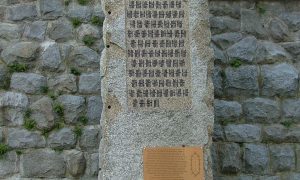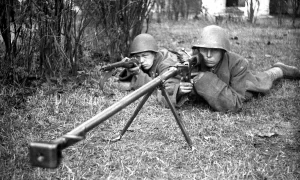August 1945 – The Soviet-Japanese War -(officially from August 9 to September 3) between the Soviet Union and the Mongolian People’s Republic on the one side and the Empire of Japan and Manchuku- on the other. The entry of the USSR, as a belligerent party, into the war of the Allies against the Japanese Empire, which had been going on for 4 years, was conditioned at the Yalta Conference meeting of Allied leaders in February 1945.


As a result, the million-strong Kwantung Army was completely defeated. According to Soviet data, its casualties amounted to 84 thousand people, about 600 thousand were taken prisoner. Irrecoverable losses of the Soviet army amounted to 12 thousand people.
Fighting on the Korean Peninsula
Korea has been a Japanese colony since 1910. The liberation of the northern part of the Korean Peninsula took place as part of the Manchurian offensive operation. The Southern Group of Forces under the command of Major General GI Shanin was allocated from the 25th Army of the 1st Far Eastern Front. This group initially consisted of the 386th Infantry Division and a number of other units, and then the 393rd Infantry Division was added to them.
In his address to the Korean people on August 8, the commander-in-chief of the Soviet troops in the Far East, Marshal A.M. Vasilevsky, called on the Koreans to rise up to fight against Japanese rule:
“IMPERIAL JAPAN WILL BE DESTROYED! Koreans! Rise to the holy war against your enslavers! Through your active struggle, you will win your right to a free and happy life. The banner of freedom and independence is rising over Seoul! Koreans in the rear – thwart Japan’s military measures by all means and means. Organize into guerrilla units. Beat the Japanese wherever you can! Koreans at the front – turn your weapons against the Japanese, beat the Japanese officers, go over to the side of the Red Army! Remember, Koreans, we have a common enemy – the Japanese! You should know that we will help you as friends in the struggle for your liberation from Japanese oppression. DEATH TO THE JAPANESE INVADERS!.”
On August 9, Soviet troops captured Gyeongheung, which became the first liberated city on Korean soil, after which one part of the troops of the Southern Group moved to Hoeren and Tumen, while the other part of the troops rushed to the ports on the northeastern coast of Korea. On August 11, a landing under the general command of Rear Admiral NS Ivanovsky landed in the port of Yuki (Ungi). Almost simultaneously with it, units of the 393rd Infantry Division entered Ungi, which left a small garrison here and continued to move towards the city of Racine (Najin). In Najin, the paratroopers landed the next day.and by August 13, they took the port and the main part of the city, and on the 14th, the amphibious assault, together with the 393rd rifle division, completely cleared the settlement of the enemy.
Having lost long-term fortifications on the border with Korea, as well as the ports of Ungi and Najin, the Kwantung Army lost contact with Japan, and its main forces were cut off from retreat to Korea. In addition, the establishment of control over Ungi and Najin provided the Red Army troops with the opportunity to take possession of Seishin (Chongjin), one of the largest naval bases in Japan, the industrial center of northeastern Korea.


The fight for Seishin went on for several days. On August 13, an amphibious detachment led by Colonel A.Z. Denisin suddenly seized the city port in a sudden raid. When the enemy launched a counterattack, a small detachment (181 people) had to go on the defensive. At dawn the next day, the first landing echelon (the 355th separate battalion of the marine corps of Major M.P.Barabolko ) landed, which, together with the vanguard, managed to capture a bridgehead in the port. Japanese troops threw aircraft and an armored train against the Soviet paratroopers. Due to poor meteorological conditions, Soviet aviation on that day could not provide support to their fighters. They received help from the sea, from the artillery of ships. They were also helped by a detachment of marines led by Captain 3rd Rank G.V. Ternovsky, who disembarked from ships and was active behind enemy lines. On the morning of August 15, the second airborne echelon landed (the 13th Marine Brigade with units under the general command of Major General V.P. Trushin ), and on the same day Soviet aviation came to the aid of the paratroopers. The brigade succeeded in driving the Japanese out of the port and pushing them back to the outskirts of the city. After the main units of the landing (335th rifle division) arrived; the 393rd division entered the city, which fought along the coast. In the second half of August 16th city seishin (Chongjin) has been completely released.
Soviet marines and a company of submachine gunners totaling 800 people landed on the berths of the port of Odejin on the evening of August 19, and in just an hour completely captured the city and the port.

Mastery of South Sakhalin and the Kuril Islands
Kuril operation
On August 18, the Kuril landing operation was launched, during which Soviet troops occupied the Kuril Islands. The Yuzhno-Sakhalin ground operation was carried out to occupy the southern part of Sakhalin. On August 18, the commander-in-chief of Soviet troops in the Far East, Marshal Vasilevsky, ordered the occupation of the Japanese island of Hokkaido by forces of two rifle divisions. This landing was not carried out due to the delay in the advance of Soviet troops in South Sakhalin, and then completely canceled by order of Stalin.
The end of the war
The main hostilities on the continent lasted 12 days, until August 20, but individual clashes continued until September 10, which became the day of the complete surrender and capture of the Kwantung Army. Soviet troops remained in northeastern China until May 1946. The fighting on the islands ended completely on September 5, 1945.
The official end of the state of war between the USSR and Japan took place on December 12, 1956, on the day the 1956 Moscow Declaration entered into force.


Meaning
The Soviet-Japanese war was of great political and military importance. On August 9, at an emergency meeting of the Supreme War Leadership Council, Japanese Prime Minister Suzuki stated:
The entry of the Soviet Union into the war this morning puts us finally in a hopeless position and makes it impossible for the further continuation of the war.
General MacArthur, commander-in-chief of the American armed forces in the Pacific Ocean, believed that “Victory over Japan can only be guaranteed if the Japanese ground forces are defeated”. US Secretary of State E. Stettinius argued the following:
On the eve of the Crimean Conference, the American chiefs of staff convinced Roosevelt that Japan could only surrender in 1947 or later, and that its defeat could cost America a million soldiers.
Dwight Eisenhower in his memoirs indicated that he addressed President Harry Truman : “I told him that since the available information indicates the inevitability of the imminent collapse of Japan, I strongly object to the entry of the Red Army into this war”.
Outcomes
For distinctions in battles as part of the 1st Far Eastern Front, 16 formations and units received the honorary name “Ussuriysk”, 19 – “Harbin”, 149 – were awarded orders. 308 thousand soldiers and officers were awarded orders and medals (87 of them became Heroes of the Soviet Union).
As a result of the war, the USSR, having fulfilled the terms of the agreements of the Yalta Conference of 1945, officially returned to its composition the territories annexed by Japan from the Russian Empire at the end of the Russo-Japanese War of 1904-1905 following the results of the Portsmouth Peace ( southern Sakhalin and, temporarily, the Kwantung region with Port -Arthur and Dalny ), as well as the main group of the Kuril Islands previously ceded to Japan in 1875 and the southern part of the Kuril Islands assigned to Japan by the Shimoda Treaty of 1855.
The last territorial loss by Japan has not been recognized to this day. According to the San Francisco Peace Treaty, Japan renounced any claims to Sakhalin (Karafuto) and the Kuriles (Tishima Ratto). Nevertheless, the treaty did not define the ownership of the islands. And the USSR, including for this reason, did not sign it. However, in 1956, the Soviet-Japanese Declaration was signed, according to which the state of war was ended and diplomatic and consular relations between the USSR and Japan were established. Article 9 of the Declaration, in particular, says:
The USSR, meeting the wishes of Japan and taking into account the interests of the Japanese state, agrees to the transfer of the Habomai Islands and the Sikotan Island to Japan, however, that the actual transfer of these islands to Japan will be made after the conclusion of the Peace Treaty.
However, immediately after the signing of the Moscow Declaration, Japan began to demand the return of the entire southern Kuril group as a precondition for negotiations on a peace treaty. This position of the Japanese government has survived to this day and prevents the conclusion of a peace treaty between Japan and Russia as the successor state of the USSR.
In addition to the USSR, after the end of World War II, Japan is engaged in territorial disputes with a number of other states. So, Japan is involved in a territorial dispute with the PRC and the Republic of China over the ownership of the Senkaku Islands, despite the existence of peace treaties between the countries (the treaty was concluded with the Republic of China in 1952, with the PRC in 1978). In addition, despite the existence of the Basic Treaty on relations between Japan and Korea, Japan and the Republic of Korea are also involved in a territorial dispute over the ownership of the Liancourt Islands.













Pingback: T-34 Tank (76 Variant) - Soviet Medium Tank - Real History Online
Pingback: BT Tank Series - WW2 Fast-Tank Series - Real History Online